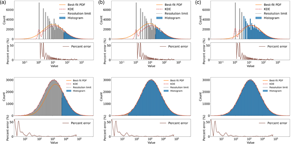Article contents
Determination of the Feature Resolution of Processed Image Data via Statistical Analysis
Published online by Cambridge University Press: 01 March 2021
Abstract

A method is presented to determine the feature resolution of physically relevant metrics of data obtained from segmented image sets. The presented method determines the best-fit distribution curve of a dataset by analyzing a truncated portion of the data. An effective resolvable size for the metric of interest is established when including parts of the truncated dataset results in exceeding a specified error tolerance. As such, this method allows for the determination of the feature resolution regardless of the processing parameters or imaging instrumentation. Additionally, the number of missing objects that exist below the resolution of the instrumentation may be estimated. The application of the developed method was demonstrated on data obtained via 2D scanning electron microscopy of a pressed explosive material and from 3D micro X-ray computed tomography of a polymer-bonded explosive material. It was shown that the minimum number of pixels/voxels required for the accurate determination of a physically relevant metric is dependent on the metric of interest. This proposed method, utilizing the prior knowledge of the distribution of metrics of interest, was found to be well suited to determine the feature resolution in applications where large datasets can be achieved.
Keywords
- Type
- Software and Instrumentation
- Information
- Copyright
- Copyright © The Author(s), 2021. Published by Cambridge University Press on behalf of the Microscopy Society of America
References
- 1
- Cited by



